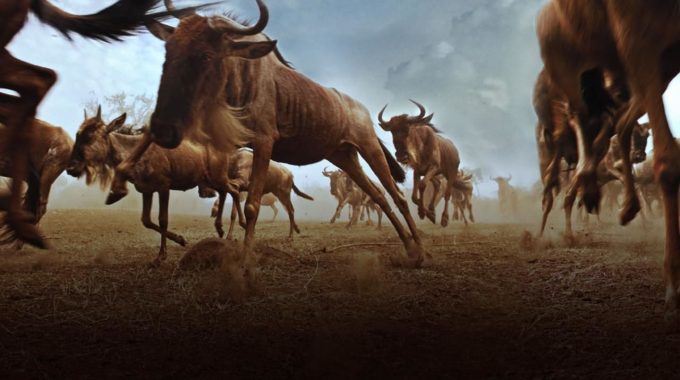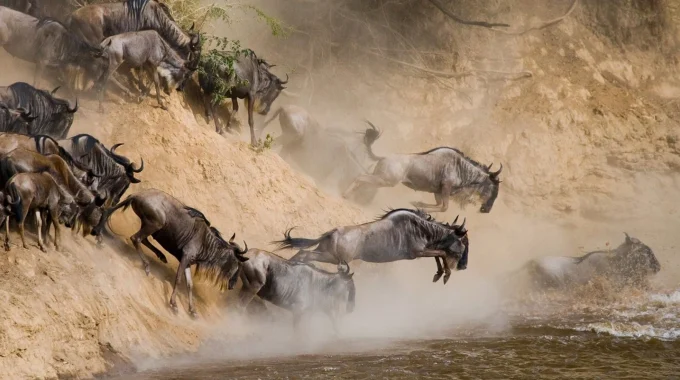The Lifespan of Wildebeest: Nature’s Marathoners
Wildebeests lifespan – Wildebeests, also known as gnus, are iconic creatures of the African savannah, easily recognizable for their long faces, sturdy bodies, and wide, curved horns. These remarkable animals are known for their epic migrations, where vast herds travel thousands of miles across the plains of East Africa in search of fresh grazing grounds. But behind the awe-inspiring spectacle lies an important question: how long do wildebeests live, and what factors influence their lifespan?

The Average Wildebeests Lifespan
In the wild, wildebeests lifespan is 20 to 30 years old, but only a fraction of them make it that far. The average life expectancy in the wild is often much shorter, with many wildebeests living to about 10 to 12 years due to various dangers and environmental factors.
While wildebeests have a relatively long life expectancy compared to some other herbivores, their survival is heavily dependent on factors like predators, disease, and food availability. In captivity, where they are protected from these dangers, wildebeests may live even longer, potentially reaching their upper age limits.
The Challenges Wildebeests Face
Wildebeests, like many animals in the African savannah, face numerous challenges that can cut their lives short:
Predation: Lions, hyenas, cheetahs, and crocodiles are their primary predators. Wildebeests often fall victim to these hunters, especially the young, weak, or sick individuals in the herd. The young calves, in particular, are highly vulnerable during the annual migration, when predators lie in wait at river crossings and open plains.
Disease: As with many large herbivores, wildebeests are susceptible to various diseases, such as anthrax, hoof-and-mouth disease, and tuberculosis. These diseases can spread rapidly, especially when large herds are crowded together during migration, leading to significant mortality rates.
Environmental Factors: Wildebeests are migratory, and the availability of food and water during migration can significantly affect their survival. Harsh dry seasons or lack of rain can lead to famine conditions, with weaker animals succumbing to hunger or dehydration.
Competition: Wildebeests share their habitat with other herbivores such as zebras, gazelles, and buffalo, competing for grazing land. The most competitive animals are often the strongest, meaning those that are older or weaker may struggle to survive, especially when resources are scarce.
The Role of Migration in Wildebeest Lifespan
Migration is central to the wildebeest’s life and survival. Each year, wildebeests embark on one of the most extraordinary migrations on Earth, moving in search of fresh grazing lands. The migration usually occurs in a circular route across the Serengeti and Masai Mara ecosystems. The long distances they cover are physically demanding, and while migration boosts the wildebeests’ chances of finding enough food, it also exposes them to numerous threats, such as dehydration, extreme weather, and predation during river crossings.
This rigorous lifestyle means that even though wildebeests are designed to travel long distances, it takes a toll on their bodies. The strenuous journey may cause injury or exhaustion, which can ultimately shorten their lifespan.
The Wildebeest Calf: A Fragile Start
The first year of a wildebeest calf’s life is the most perilous. Calves are born with the ability to stand and run within hours of birth, an adaptation that helps them evade predators in their early weeks. However, only a small percentage of calves make it past their first year. They are vulnerable to predators, disease, and other environmental hazards.
After the first year, calves start to become more resilient, but they still face dangers in the wild. As they grow, their chances of surviving into adulthood increase, especially if they manage to avoid predators and stay with the herd.
Factors That Affect Lifespan in Captivity
In captivity, the lifespan of wildebeests can be extended due to the absence of natural predators and the provision of consistent food and water. Without the constant threats of predation, disease outbreaks, or migration struggles, captive wildebeests may live longer lives, often surpassing 20 years. However, it’s important to note that captivity also comes with its own challenges, such as limited space and lack of natural social structures, which may affect their overall well-being.
Conclusion
The wildebeest’s lifespan is a testament to their resilience in the wild. Although they face significant threats from predators, disease, and environmental factors, their ability to adapt to the harsh conditions of the African savannah allows them to live for up to 20 to 30 years, if they manage to survive the dangers of their youth. The wildebeest’s survival depends largely on the strength of its herd, the conditions of its environment, and its ability to avoid the predators that constantly threaten it.
These incredible creatures continue to fascinate scientists and wildlife enthusiasts alike, not only for their physical prowess and migration but for the profound ways in which they balance the demands of survival with the rhythms of the African landscape.
You can read our Complete Guide to Wildebeest Migration in Africa



